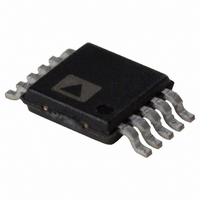AD7980BRMZ Analog Devices Inc, AD7980BRMZ Datasheet - Page 8

AD7980BRMZ
Manufacturer Part Number
AD7980BRMZ
Description
ADC 16BIT 1MSPS 1.25LSB 10-MSOP
Manufacturer
Analog Devices Inc
Series
PulSAR®r
Datasheet
1.AD7980ARMZRL7.pdf
(28 pages)
Specifications of AD7980BRMZ
Data Interface
DSP, MICROWIRE™, QSPI™, Serial, SPI™
Number Of Bits
16
Sampling Rate (per Second)
1M
Number Of Converters
1
Power Dissipation (max)
10mW
Voltage Supply Source
Single Supply
Operating Temperature
-40°C ~ 125°C
Mounting Type
Surface Mount
Package / Case
10-TFSOP (0.118", 3.00mm Width)
Resolution (bits)
16bit
Sampling Rate
1MSPS
Input Channel Type
Differential
Supply Voltage Range - Analog
2.375V To 2.625V
Supply Current
350pA
Lead Free Status / RoHS Status
Lead free / RoHS Compliant
Available stocks
Company
Part Number
Manufacturer
Quantity
Price
Company:
Part Number:
AD7980BRMZ
Manufacturer:
ADI
Quantity:
1 000
Part Number:
AD7980BRMZ
Manufacturer:
ADI/亚德诺
Quantity:
20 000
Part Number:
AD7980BRMZ-RL7
Manufacturer:
ADI/亚德诺
Quantity:
20 000
Company:
Part Number:
AD7980BRMZRL7
Manufacturer:
ADI
Quantity:
1 000
AD7980
TERMINOLOGY
Integral Nonlinearity Error (INL)
INL refers to the deviation of each individual code from a line
drawn from negative full scale through positive full scale. The
point used as negative full scale occurs ½ LSB before the first
code transition. Positive full scale is defined as a level 1½ LSB
beyond the last code transition. The deviation is measured from
the middle of each code to the true straight line (see Figure 26).
Differential Nonlinearity Error (DNL)
In an ideal ADC, code transitions are 1 LSB apart. DNL is the
maximum deviation from this ideal value. It is often specified in
terms of resolution for which no missing codes are guaranteed.
Offset Error
The first transition should occur at a level ½ LSB above analog
ground (38.1 μV for the 0 V to 5 V range). The offset error is
the deviation of the actual transition from that point.
Gain Error
The last transition (from 111 … 10 to 111 … 11) should
occur for an analog voltage 1½ LSB below the nominal full
scale (4.999886 V for the 0 V to 5 V range). The gain error is
the deviation of the actual level of the last transition from the
ideal level after the offset is adjusted out.
Spurious-Free Dynamic Range (SFDR)
SFDR is the difference, in decibels (dB), between the rms
amplitude of the input signal and the peak spurious signal.
Effective Number of Bits (ENOB)
ENOB is a measurement of the resolution with a sine wave
input. It is related to SINAD by the following formula
and is expressed in bits.
Noise-Free Code Resolution
Noise-free code resolution is the number of bits beyond which
it is impossible to distinctly resolve individual codes. It is
calculated as
and is expressed in bits.
ENOB = (SINAD
Noise-Free Code Resolution = log
dB
− 1.76)/6.02
2
(2
N
/Peak-to-Peak Noise)
Rev. B | Page 8 of 28
Effective Resolution
Effective resolution is calculated as
and is expressed in bits.
Total Harmonic Distortion (THD)
THD is the ratio of the rms sum of the first five harmonic
components to the rms value of a full-scale input signal and is
expressed in dB.
Dynamic Range
Dynamic range is the ratio of the rms value of the full scale to
the total rms noise measured with the inputs shorted together.
The value for dynamic range is expressed in dB. It is measured
with a signal at −60 dBFS to include all noise sources and DNL
artifacts.
Signal-to-Noise Ratio (SNR)
SNR is the ratio of the rms value of the actual input signal to the
rms sum of all other spectral components below the Nyquist
frequency, excluding harmonics and dc. The value for SNR is
expressed in dB.
Signal-to-(Noise + Distortion) Ratio (SINAD)
SINAD is the ratio of the rms value of the actual input signal to
the rms sum of all other spectral components below the Nyquist
frequency, including harmonics but excluding dc. The value for
SINAD is expressed in dB.
Aperture Delay
Aperture delay is the measure of the acquisition performance. It
is the time between the rising edge of the CNV input and when
the input signal is held for a conversion.
Transient Response
Transient response is the time required for the ADC to
accurately acquire its input after a full-scale step function is
applied.
Effective Resolution = log
2
(2
N
/RMS Input Noise)













